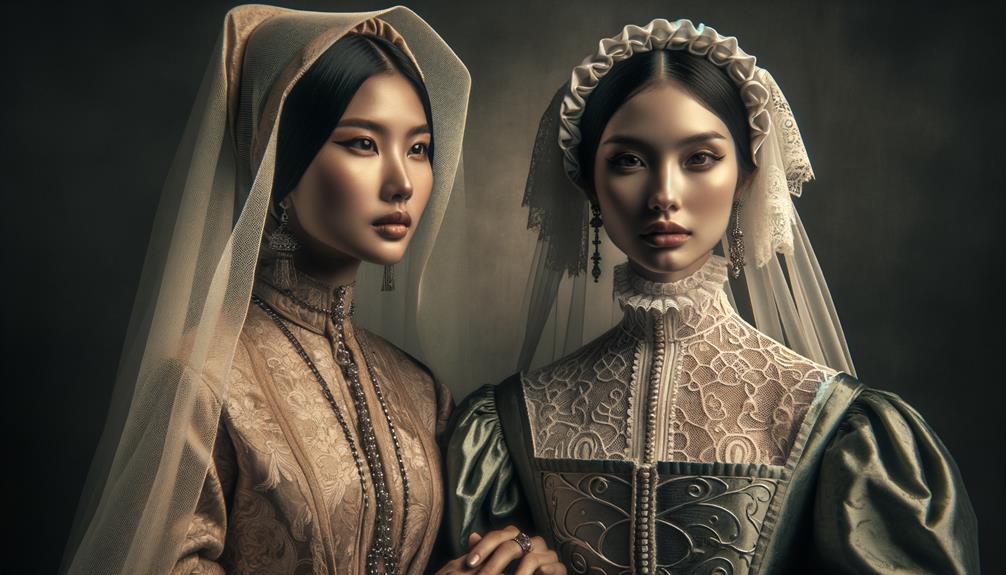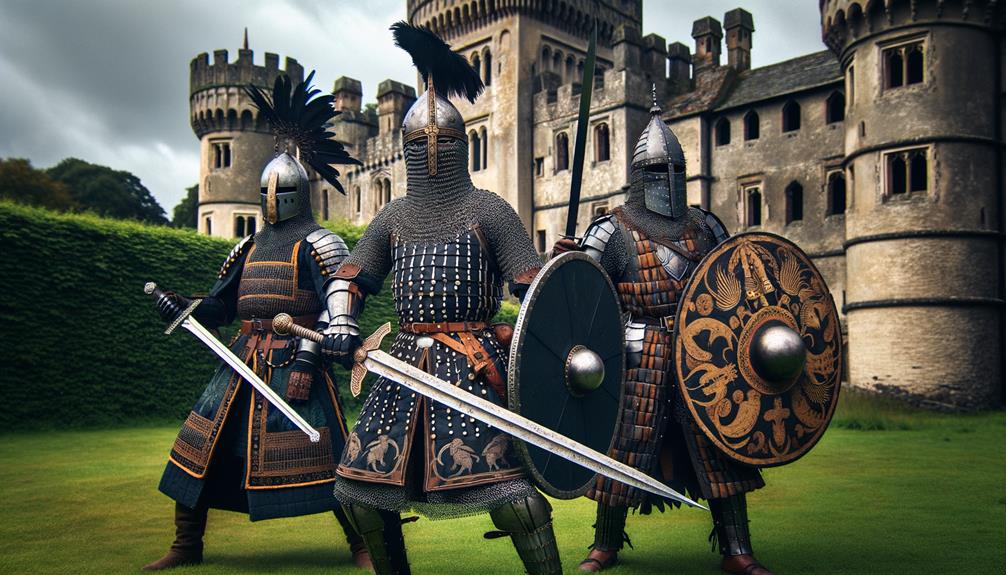I've always been fascinated by the depiction of fashion in medieval art manuscripts. The illustrations capture the essence of societal norms and individual identities in a way that's both captivating and revealing. The stark contrast between the luxurious fabrics and intricate details of noble attire and the plain, practical garments of peasants speaks volumes about the era's social hierarchy. Even the accessories and jewelry hold significance, symbolizing wealth, virtue, and social status. The meticulous artistry and use of materials like vellum and gold leaf showcase the era's exceptional craftsmanship. As I delve into these images, I uncover a rich narrative that reveals more than just clothing – it exposes the complexities of medieval life. What do these sartorial choices say about the people who wore them, and what do they reveal about the world they lived in?
Medieval Court Attire
Observing medieval court attire, you can't help but notice garments like the cote hardy, pourpoint, and houpeland, which reflect significant societal changes. These pieces, beautifully depicted in illuminated manuscripts, tell the story of evolving fashion in France and Flanders from 1330 to 1515. The cote hardy, a close-fitting garment, and the pourpoint, a padded doublet, reveal a shift towards tailored elegance. The houpeland, with its voluminous sleeves and ornate designs, embodies the grandeur of the court.
As I delve into these manuscripts, I see how historical events like the Black Death and the Hundred Years War left their mark on fashion. The somber tones and practical designs during these periods speak volumes. Yet, a transformation emerges towards the late medieval period – garments become more fluid, allowing dynamic movement, hinting at a society in flux, yearning for change.
The illuminated manuscripts serve as a window into this world, capturing the essence of medieval court attire. They highlight not just the clothing but the societal shifts and innovations in fashion. These garments, meticulously depicted, offer a glimpse into the lives and aspirations of those who wore them, reflecting a time of transformation and adaptation.
Everyday Garments
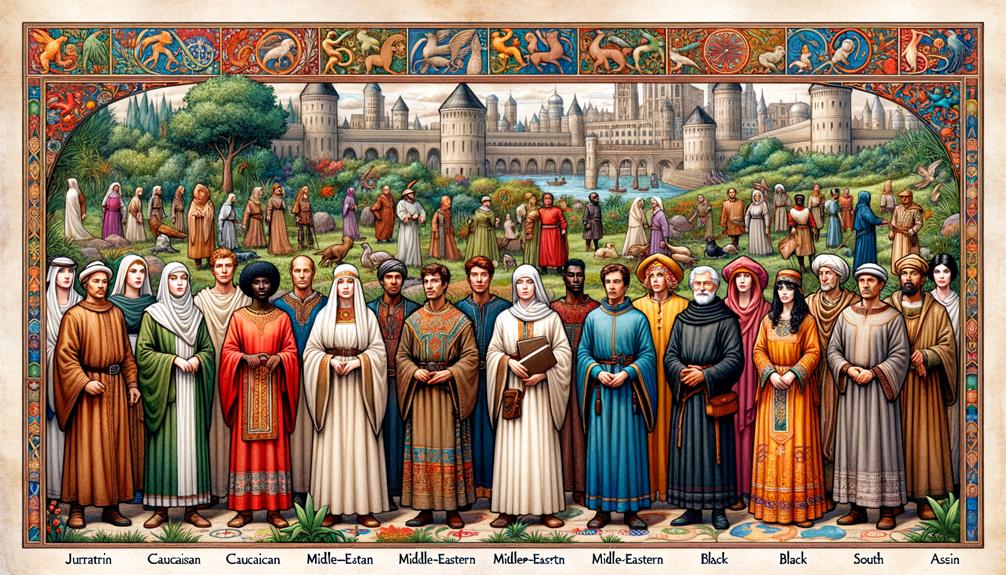
In medieval illuminated manuscripts, everyday garments like tunics, gowns, and hoods offer a unique glimpse into the practical and subtle elegance of medieval life. These depictions of dress in art provide a window into the Middle Ages, showcasing materials like linen, wool, and fur. Each detail speaks to the functionality of the garments, highlighting fastenings, layering, and how fabric drapes over the body.
When examining these images, it's clear that fashion in the Middle Ages was more than just clothing; it was a reflection of social status and occupation. The simplicity of a peasant's tunic, for instance, contrasts with the slightly more decorated gown of a merchant. These variations tell stories of daily life, of work and routine, captured in the strokes of an artist's brush.
Regional and cultural differences come alive through these manuscripts, revealing how different classes adapted their attire to their surroundings. This adaptability is a testament to human ingenuity. The everyday garments depicted are not just pieces of cloth but pieces of history, woven into the fabric of our understanding of the past.
Accessories and Jewelry
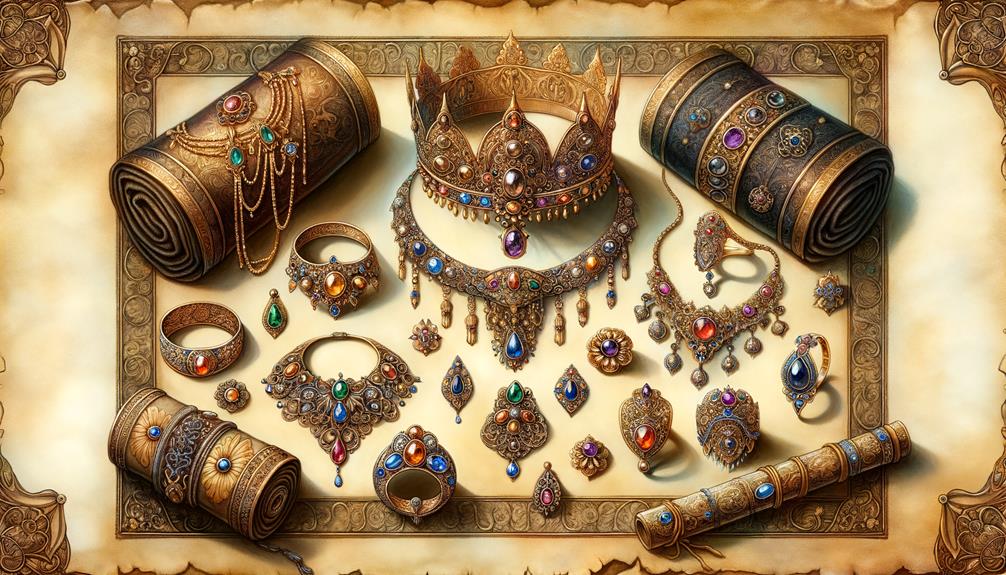
In the vibrant world of medieval manuscripts, accessories and jewelry reveal the subtleties of identity and social standing. I'm fascinated by the intricate details, particularly in pieces like the Royal Gold Cup. The craftsmanship is extraordinary, with each ornament serving as a testament to the wearer's virtues and social status.
Elizabeth I's jewelry, inspired by these manuscripts, celebrated female leadership and virtue. Her pieces often featured symbols of virgin goddesses and Lucretia, highlighting her moral integrity and strength. This intersection of fashion and manuscript art creates a dialogue between the past and present, showing how accessories were more than just adornments – they were statements of power and identity.
Dr. Nayal's fashion collection, drawing inspiration from British Library manuscripts, brings this historical elegance into contemporary design. At the 2018 Met Gala, attendees like Ezra Miller showcased manuscript-inspired accessories, blending ancient artistry with modern fashion innovation. As I reflect on these pieces, I see a continuous thread connecting past and present, where accessories and jewelry transcend time, embodying the essence of the era they represent. Manuscripts, in this light, are not just relics but living inspirations for today's fashion.
Symbolism in Fashion
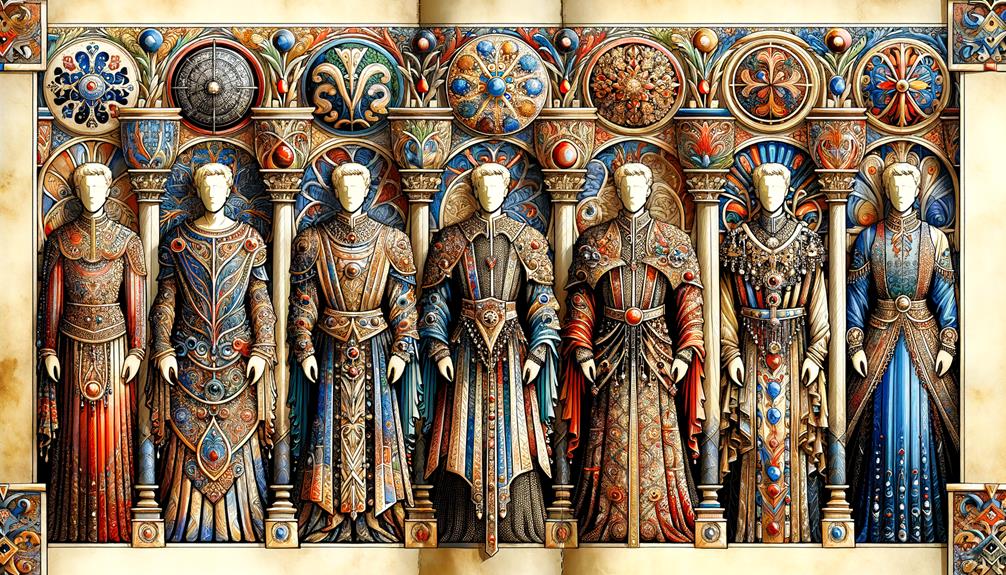
Fashion in medieval manuscripts is more than just aesthetically pleasing; it's a rich tapestry of symbols that reveal the essence of society. Each garment and accessory in these illuminated manuscripts and early works of art tells a story, reflecting the complex layers of social status, profession, and character traits.
As I delve into fashion history, I notice that clothing choices are deliberate, mirroring the societal norms and cultural influences of the time. In these medieval manuscripts, the subtle details in attire enhance storytelling, making each character come alive with a distinct role and identity.
The symbolism in fashion becomes apparent when observing the depiction of wealth through luxurious fabrics and intricate designs. Virtue and moral standing are often signified by the simplicity or modesty of one's dress. Even social hierarchy is woven into the fabric, with certain colors and styles reserved for nobility.
These fashion elements aren't merely decorative; they provide a window into the values, beliefs, and aspirations of medieval society. By decoding these sartorial symbols, we gain a deeper understanding of the historical context and the human experience within it.
Craftsmanship and Materials
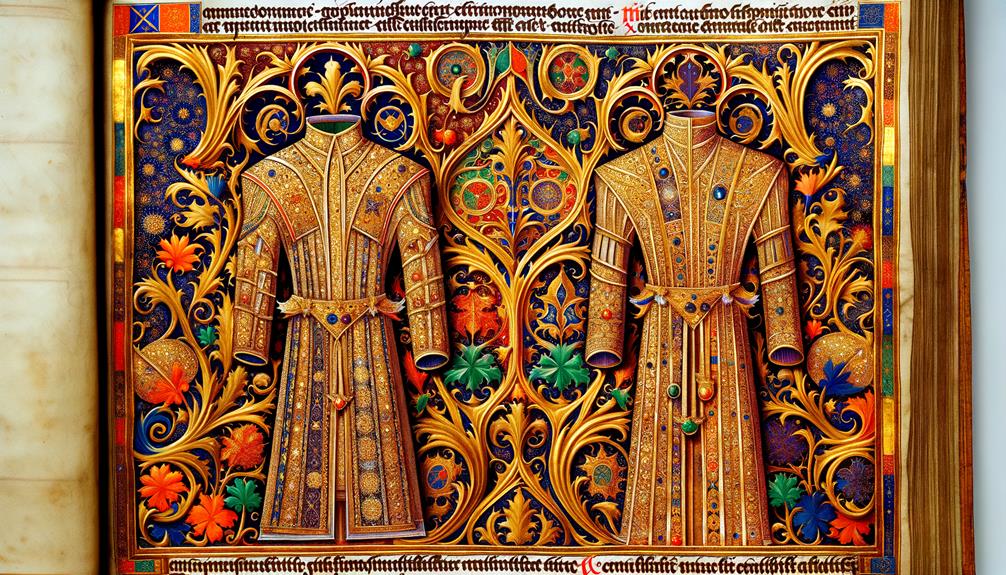
Diving into the craftsmanship of medieval manuscripts, I'm struck by the meticulous artistry that brought these works to life. The intricate detailing speaks to the importance and skill of the artisans. Each manuscript is a testament to the precision and patience required to illuminate fashion through art.
The materials used were just as crucial as the techniques. Vellum and parchment provided the canvas, while gold leaf and lapis lazuli added a richness that still dazzles today. These materials weren't chosen lightly; they were carefully selected to enhance the visual impact and longevity of the manuscripts. Gold leaf wasn't just for show – it symbolized divinity and importance, adding layers of meaning to the works.
Illuminators played a significant role, painting and embellishing with vibrant colors and intricate designs. Their craftsmanship turned manuscripts into vivid, enduring records of historical fashion. The pigments, like the deep blues from lapis lazuli, were painstakingly prepared and applied, showcasing a level of detail that's awe-inspiring.
In medieval manuscripts, the fusion of craftsmanship and materials created masterpieces that captured the essence of their time. These works stand as a bridge between the past and the present, illuminating fashion in a way that continues to inspire.
Social Status and Clothing
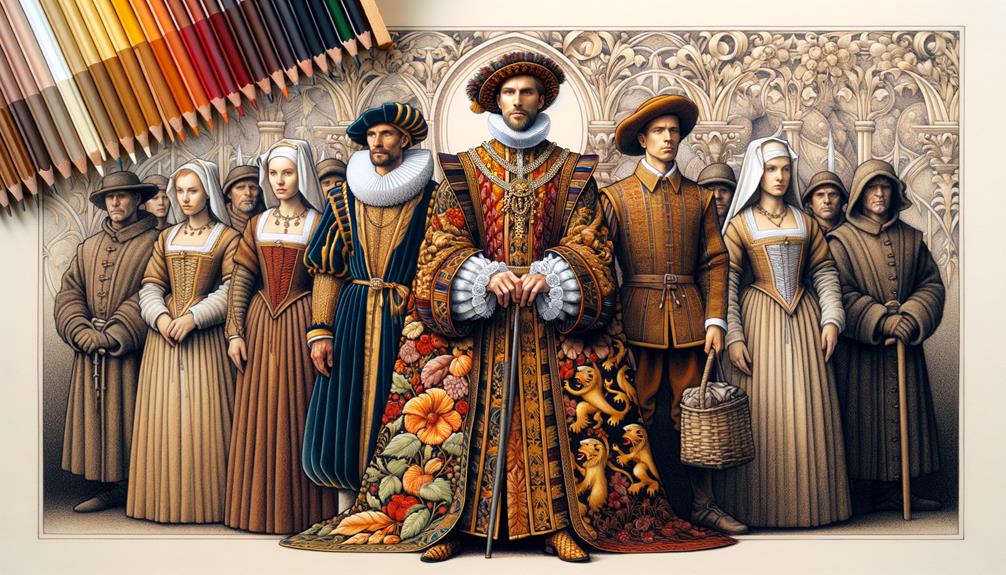
When I gaze at illuminated manuscripts, I notice how strict social rules governed what people wore. The wealthy elite flaunted their riches with lavish attire, while peasants' clothing remained humble and practical. The stark contrast in their attire speaks volumes about the rigid social hierarchy and class distinctions of the time.
Sumptuary Laws Impact
Sumptuary laws in the Middle Ages starkly reflected and reinforced the rigid social hierarchy through clothing restrictions. These laws dictated who could wear what, from the color of a dress to the type of fabric adorning one's person. The aim was to keep the middle and lower classes in their place, preventing them from mimicking the wealthy.
I find it fascinating how these laws were both a tool of control and a catalyst for quiet rebellion. The impact of sumptuary laws on fashion was profound. They were intended to curb any semblance of a fashion revolution, yet innovation often finds its way through the cracks.
People found subtle ways to express their defiance, perhaps through a slightly richer shade of color or a more luxurious lining hidden from casual view. These small acts challenged the status quo, revealing a yearning for individuality and upward mobility. Today, we see echoes of this in how fashion continually evolves, pushing against boundaries, and seeking new ways to redefine identity. In those medieval manuscripts, we see more than just clothing; we see a silent dialogue of resistance and aspiration.
Nobility's Extravagant Attire
Nobility's attire in medieval manuscripts is a vivid display of their social dominance and wealth. The extravagant attire depicted highlights the vast difference between the privileged and the ordinary. Luxurious fabrics like velvet and fur, intricate embroidery, and jeweled headpieces aren't just fashion statements; they're declarations of power and prestige.
I'm drawn to the meticulous details in these medieval manuscripts. Each velvet gown and fur-trimmed robe tells a story, revealing the wearer's rank. These visual narratives are almost palpable, transporting us to a world where clothing isn't merely functional but a potent symbol of social status.
The opulent garments, with their sumptuous textures and elaborate accessories, reflect a life of privilege. It's fascinating how the nobility's fashion choices were not just about personal taste but a strategic display of wealth. The jeweled headpieces, in particular, are striking, shimmering symbols of authority.
In these manuscripts, clothing transcends its materiality, becoming a canvas for expressing societal hierarchies. The portrayal of extravagant attire underscores the nobility's access to luxury, making their social dominance visually undeniable. Through these rich depictions, we glimpse a world where dress defines and delineates power.
Peasant Clothing Constraints
Peasant clothing in medieval manuscripts paints a stark contrast to the nobility's opulence, revealing a life bound by necessity and constraint. These depictions expose the harsh realities of social status and the medieval social hierarchy. Each illustration showcases the simplicity of peasant life through their practical clothing – tunics, hoods, and simple footwear.
The materials and designs seen are utilitarian, often recycled, reflecting a lack of resources. This wasn't just about fabric; it was about survival. The garments, though plain, tell stories of resilience. They weren't adorned with embellishments or vibrant colors. Instead, they were practical and functional, suited for arduous labor.
This visual record in manuscripts highlights the sharp divide between peasants and the elite. The disparity in clothing underscores the rigid social stratification of the time. While nobles flaunted their wealth through extravagant attire, peasants wore their constraints.
These images are more than just fashion; they are windows into the past, showing us how deeply clothing was intertwined with identity and status. In this, we find a certain dignity and perseverance, despite the constraints. The simplicity of peasant clothing speaks volumes about the era's social fabric.
Frequently Asked Questions
What Is Fashion in Art?
Fashion in art is a fascinating reflection of our collective style sense, capturing the essence of clothing and aesthetics within creative expression. It's intriguing to see how it mirrors societal norms, cultural influences, and individual identity, serving as a visual chronicle of our evolving tastes and inspirations.
What Are Three Main Fashion Categories?
Fashion can be broadly categorized into three main groups: courtly clothing, women's fashion, and men's fashion. Each category has its unique essence, driving innovation through evolving styles and cultural influences.
Is Clothing a Form of Art?
I firmly believe that clothing is a form of art. It goes beyond mere function, embodying creativity, cultural significance, and personal expression. Each piece tells a unique story, pushing boundaries and challenging traditional norms. The fashion world is constantly evolving, redefining itself with each new trend and style.
Why Was Fashion Important in Medieval Times?
Fashion in medieval times was vital as it reflected social standing and identity. Clothing wasn't just about aesthetics; it symbolized power, wealth, and status. What people wore communicated their position in society, shaping how others perceived and interacted with them.



